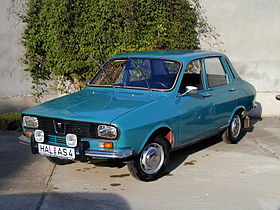Dacia 1310
| Dacia 1300 | |
|---|---|
 |
|
| Overview | |
| Manufacturer | Dacia |
| Production | 1969–2004 |
| Model years |
1969–1982 1982–1984 1984–1991 1990–1993 1994–1999 1999–2004 |
| Assembly | Mioveni, Romania |
| Body and chassis | |
| Class |
Large family car (Dacia 1300) Small family car (Dacia 1310) |
| Body style | 4-door saloon 5-door estate 2-door coupé 2-door pick up (Dacia Pick-Up 1302/1304/1305) 4-door pick up (Dacia Pick-Up 1307/1309) |
| Layout | Front-engine, front-wheel-drive |
| Related | Renault 12 |
| Powertrain | |
| Engine | 1.2 L I4 (gasoline) 1.3 L I4 (gasoline) 1.4 L I4 (gasoline) 1.6 L I4 (gasoline) |
| Transmission | 4-speed manual 5-speed manual |
| Dimensions | |
| Wheelbase | 2,441 mm (96.1 in) |
| Length | 4,340 mm (170.9 in) (1300-saloon) 4,348 mm (171.2 in) (1310-saloon) 4,404 mm (173.4 in) (estate) 4,148 mm (163.3 in) (coupé) |
| Width | 1,636 mm (64.4 in) |
| Height | 1,435 mm (56.5 in) (1300-saloon) 1,355 mm (53.3 in) (1310-saloon) 1,455 mm (57.3 in) (estate) 1,250 mm (49.2 in) (coupé) |
| Curb weight | 930 kg (2,050 lb) (1300-sedan) 940 kg (2,070 lb) (1310-sedan) 960 kg (2,120 lb) (estate) 880 kg (1,940 lb) (coupé) |
| Chronology | |
| Predecessor | None |
| Successor | Dacia Logan |
The Dacia 1300 (Romanian pronunciation: [ˈdat͡ʃia]) was (at the time of its launch) a medium-sized family car, built during the Cold War by Romanian auto maker Dacia. The "1300" stands for the engine displacement. The first Dacia 1300 left the assembly line on 23 August 1969. On 21 July 2004 the last Dacia 1310 (sedan version), number 1,959,730, rolled out the gates of the Mioveni production facility, just one month before its 35th anniversary.
The Romanian government of the 1960s had decided to acquire the tooling and basic design of a modern, western automobile, in order to offer their own car to the Romanian people. Terms stated that the vehicle had better not be expensive, large enough for a family, and had to be powered by an engine no larger than 1.3 litres. Offers came from Alfa Romeo, Fiat, Austin and others, but the winner was the Renault 12. The decision towards the French car was probably political to a large extent but sound, nonetheless. Most of the resulting vehicles were sold to consumers in the Communist Eastern bloc and in export markets such as South America, Canada, China, or North Korea, but also Great Britain or the Netherlands. When automobile production started at the Mioveni factory, the Renault 12 was but a prototype, for which reason, Renault offered CKD kits and tooling for the older Renault 8 Major, as a temporary replacement, resulting in the Dacia 1100, for a few years until the much awaited Romanian people's car would arrive. Both the R12 and its licensed copy, were launched in 1969. During the first few years of production, the plant assembled CKD kits imported from France. At the time of its launch, the 1300 was a modern car offering good comfort, safety, good performance and reliability, and even more so by eastern standards of the time, set by 1960's and 70's Skodas, Ladas, Moskwich, Wartburgs and other eastern block industry creations.
The 1300 was subject to multiple facelifts in an effort to maintain consumers' interest in the model, but the basic design was kept for its entire 35-year lifespan. Although performance and fuel consumption were gradually improved, quality didn't always meet the standard once they had stopped importing CKD kits. Bodypanel corrosion became the model's number one problem. Air conditioning, airbags and anti-lock brakes, were never offered.
...
Wikipedia
